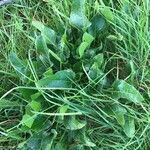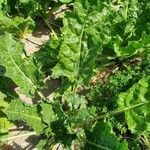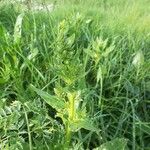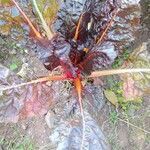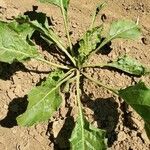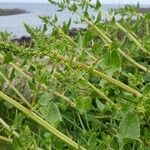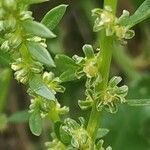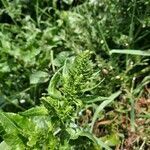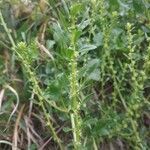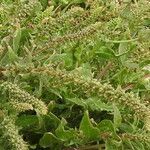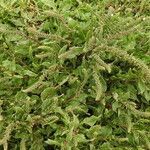Glabrous or almost glabrous annual, biennial, or short-lived perennial herb. Taproot stout, but not usually strongly thickened. Basal lvs usually forming rosette at first. Petiole to c. 20 cm long; lamina very variable according to habitat, usually to 20 × 15 cm, ovate or oblong-ovate, glossy, puckered or bullate; margin undulate; base generally cordate. Flowering stems 30-100 cm high, with few to many branches; cymes 1-4-flowered, dense above, more interrupted towards base of stem; lvs and leaflike bracts smaller and more linear toward top of stem, often scarcely > glomerules. Perianth segments 1.7-2.5 mm long, oblong, green with hyaline margin, incurved, scarcely accrescent. Stamens included. Fruiting ovary 2-4 mm across top, flat, orbicular. Seed deep glossy brown.
A dark green leafed plant. The plant is upright and about 20 cm tall. It can be grown as an annual plant. Normally it gives a thickened root in the first year then flowers in the second year. The leaves vary in shape and colour. They can be oval with an irregular wavy edge. They can be dark green or reddish. It has a round or elongated fattened root. The root is red in colour. (White varieties also occur). The flowers are small and green and have both sexes. They occur in flower arrangements with the end bud a flower bud. This forms a tall, branching, spike-like arrangement. The fruit are one seed. Often 2 or more seeds are joined together in a "seedball". Plants are wind cross pollinated.
Erect annual, occasionally perennial herb, 0.2-2.0 m high, with furrowed, glabrous stems; roots woody, fleshy or much swollen. Leaves alternate, dark green to reddish, up to 120 x 60 mm, flat, entire or nearly so, long-petiolate. Inflorescences spike-like branches, composed of small, (1)2-4-flowered clusters, falling off at maturity. Flowers bisexual, sessile. Tepals 5, green or whitish, often connate with other flowers in the glomerule, perigynous. Fruit becomes detached at maturity, opening by a lid (operculum).
Roots fibrous or fleshy. Leaves: petiole 1/2-2/3 or equaling blade length; blade dark red to green, usually with pronounced midrib, somewhat fleshy. Inflorescences cymes, 1-8-flowered, interrupted towards base. Perianth urn-shaped; segments 3-5 × 2-3 mm; receptacle pelviform. Achenes 5-11 per cluster, 3-5 mm. Seeds 1.5-2 mm.

